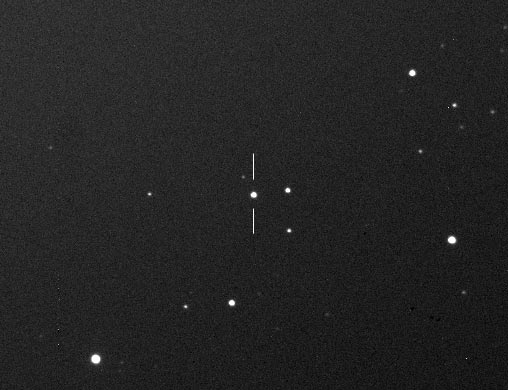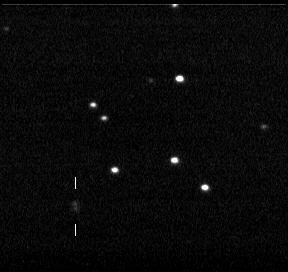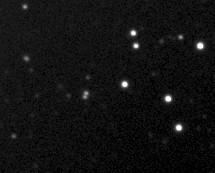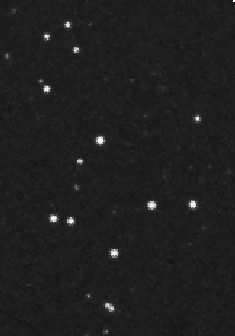

This image shows the closest quasar, 3c273.0 in Virgo. Apparent magnitude is 12.85, absolute brightness MBol = -26.9 mag and its redshift is z=0.158.
December 17, this was the Night of the year 1998. I was out for eleven hours and just before dawn I tried my first gravitational lens, the famous "double quasar" Q0957+561A/B at redshift z = 1.41, really far out in the universe!Gravitational lenses show Einstein's General Theory of Relativity at work, because they were predicted for a long time but none could be detected, and many astronomers had begun to see a kind of science fiction in them. As the General Theory of Relativity is the adequate theory for the large scale structures in the universe and also the theory for really strong gravitational fields, which both are unavailable to physicists and astronomers under normal conditions, it is extremely difficult to find experimental verification for the predictions made by such theories. Only few experiments over the last eighty years were possible.
Gravitational lenses enable astronomers to attack the problem of the 'missing mass' by modeling the mass of the lensing cluster and the distribution of the matter inside.
Out of historical reasons, because Q0957+561A/B was the first gravitational lens detected in 1979, it is one of the best studied objects of this class. The data analysis has lead to a lensing cluster of galaxies at redshift z = 0.355 surrounding the central lens galaxy G1, which is of mag 18.3 in the red band of the spectrum. The cluster is identified as a poor to medium rich one, dominated by the giant elliptical galaxy (G1), which is accompanied by a large fraction of late type spirals. Another cluster of galaxies at z = 0.5 distorts somewhat the lensing effect .
The two components of the double quasar are of mag 16.5 (A) and 16.2 (B), but, quite normal for quasars a certain variability is known, observable in both components after a certain time delay. G1 is located between the two, but much closer to brighter component B, A and B have an angular distance of 6.1" .
 Q0957+561A/B,Double quasar in UMa, 03/17/99, jpeg, 10k
Q0957+561A/B,Double quasar in UMa, 03/17/99, jpeg, 10k
The original image from Dec 17, 1998 was replaced by this better version, which was made without focal reducer. 5 images of 45 seconds integration time were median combined.
 Q0957+561A/B, Image 02/24/03 10" Newton, ST8E, jpeg, 11k
Q0957+561A/B, Image 02/24/03 10" Newton, ST8E, jpeg, 11k
11 images of 2200 seconds total integration time were added here to achieve a better S/N-ratio.
 Q0957+561A/B, Image
for comparison from DSS, jpeg, 4k
Q0957+561A/B, Image
for comparison from DSS, jpeg, 4k
Although the bad signal to noise ratio of such a dim object does not allow me to make a precise photometric measurement, it is obvious that component A is brighter in relation to B in the DSS-image, made at some time in the sixties.
Since 1996 it is known that an observed variation in brightness in one component is repeated in the otherone 400 days later, because this light has to travel a longer distance.
The following two images show many more gravitational lenses in action. I forgot where I once found this great collection on the internet, so I beg the pardon of the authors.
Many more examples and data at Harvard-Smithsonian Center for Astrophysics
As you can see, a lot of work needs to be done !
Read more about a New Method Using Gravitational Lensing Yields Expansion Rate of Universe
Many more links can be found on the page of Peter Schneider
Comments welcome, contact:
